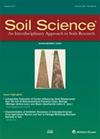Biotic factors dominantly determine soil inorganic carbon stock across Tibetan alpine grasslands
4区 农林科学
Q2 Agricultural and Biological Sciences
引用次数: 7
Abstract
Abstract. The soil inorganic carbon (SIC) pool is a major component of soil carbon (C) pools, and clarifying the predictors of SIC stock is urgent for decreasing soil C losses and maintaining soil health and ecosystem functions. However, the drivers and their relative effects on the SIC stock at different soil depths remain largely unexplored. Here, we conducted a large-scale sampling to investigate the effects and relative contributions of abiotic (climate and soil) and biotic (plant and microbe) drivers on the SIC stock between topsoils (0–10 cm) and subsoils (20–30 cm) across Tibetan alpine grasslands. Results showed that the SIC stock had no significant differences between the topsoil and subsoil. The SIC stock showed a significant increase with altitude, pH and sand proportion, but declined with mean annual precipitation (MAP), plant aboveground biomass (PAB), plant coverage (PC), root biomass (RB), available nitrogen (AN), microbial biomass carbon (MBC), and bacterial abundance (BA) and fungal gene abundance (FA). For both soil layers, biotic factors had larger effects on the SIC stock than abiotic factors did. However, the relative importance of these determinants varied with soil depth, with the effects of plant and microbial variables on SIC stock weakening with soil depth, whereas the importance of climatic and edaphic variables increased with soil depth. Specifically, BA, FA and PC played dominant roles in regulating SIC stock in the topsoil, while soil pH contributed largely to the variation of SIC stock in the subsoil. Our findings highlight differential drivers over SIC stock with soil depth, which should be considered in biogeochemical models for better simulating and predicting SIC dynamics and its feedbacks to environmental changes.青藏高寒草原土壤无机碳储量主要受生物因子影响
摘要土壤无机碳库是土壤碳库的主要组成部分,明确土壤无机碳储量的预测因子是减少土壤碳流失、维护土壤健康和生态系统功能的迫切需要。然而,不同土壤深度下碳化硅储量的驱动因素及其相对影响在很大程度上尚未得到研究。在此基础上,研究了西藏高寒草原表层土壤(0 ~ 10 cm)和底土(20 ~ 30 cm)土壤中,非生物(气候和土壤)和生物(植物和微生物)驱动因子对SIC储量的影响及其相对贡献。结果表明,表层土壤和底土土壤的SIC储量差异不显著。SIC储量随海拔高度、pH和沙粒比例显著增加,随年平均降水量(MAP)、植物地上生物量(PAB)、植物盖度(PC)、根系生物量(RB)、有效氮(AN)、微生物生物量碳(MBC)、细菌丰度(BA)和真菌基因丰度(FA)下降。在两层土壤中,生物因子对SIC储量的影响均大于非生物因子。然而,这些决定因素的相对重要性随土壤深度而变化,植物和微生物变量对碳化硅储量的影响随土壤深度而减弱,而气候和土壤变量的重要性随土壤深度而增加。其中,BA、FA和PC对表层土壤中SIC储量的调节起主导作用,而土壤pH对底土中SIC储量的变化起主要作用。我们的研究结果强调了土壤深度对碳化硅存量的差异驱动因素,为了更好地模拟和预测碳化硅动态及其对环境变化的反馈,生物地球化学模型应该考虑这些因素。
本文章由计算机程序翻译,如有差异,请以英文原文为准。
求助全文
约1分钟内获得全文
求助全文
来源期刊

Soil Science
农林科学-土壤科学
CiteScore
2.70
自引率
0.00%
发文量
0
审稿时长
4.4 months
期刊介绍:
Cessation.Soil Science satisfies the professional needs of all scientists and laboratory personnel involved in soil and plant research by publishing primary research reports and critical reviews of basic and applied soil science, especially as it relates to soil and plant studies and general environmental soil science.
Each month, Soil Science presents authoritative research articles from an impressive array of discipline: soil chemistry and biochemistry, physics, fertility and nutrition, soil genesis and morphology, soil microbiology and mineralogy. Of immediate relevance to soil scientists-both industrial and academic-this unique publication also has long-range value for agronomists and environmental scientists.
 求助内容:
求助内容: 应助结果提醒方式:
应助结果提醒方式:


